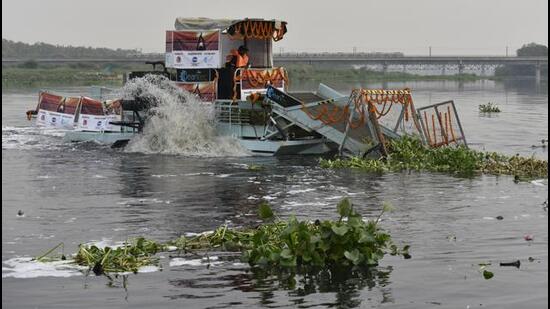Namami Gange: A new phase, new ambitions
Ganga’s environmental cleansing has aided the people’s spiritual cleansing, which was witnessed when more than 200 million people took a bath during the Kumbh. Likewise, increased sightings of Gangetic dolphins, gharials, otters and other aquatic species serve as a reminder of the river’s improved health
August 7, 2021, was a momentous day when Neeraj Chopra won the gold at the Tokyo Olympics. While this achievement made headlines, not many know that the athlete donated his javelin for the Namami Gange Programme (National Mission for Clean Ganga/NMCG) auction. A tradition initiated by Prime Minister (PM) Narendra Modi, the auctioning of gifts for NMCG underlines his involvement and the government’s commitment to the programme. On December 15, this commitment achieved a strong endorsement when NMCG was recognised by the United Nations as one of the world’s top 10 ecosystem restoration programmes. NMCG started in 2014 when the PM launched it to restore the river’s health. Enthused by the vision of aviral (unrestricted flow) and nirmal (unpolluted flow) Ganga, a holistic and integrated approach was initiated. This was further reinforced by three verticals: Jan Ganga (public participation and people-river connect), Gyan Ganga (research and knowledge management), and Arth Ganga (self-sustainable economic model).

To date, 406 projects worth ₹32,898 crore have been sanctioned for setting up sewage treatment infrastructure, riverfront development, river surface cleaning, biodiversity protection, afforestation, public awareness and industrial effluent monitoring, and Arth Ganga. 225 projects have been completed; the remaining are under various stages of execution. In addition, about 177 sewage infrastructure projects have been sanctioned to create 5,270 million litres per day (MLD) treatment capacity and a 5,211-km sewer network. Several have been completed.
With a large part of the initial stage achieved, we are initiating Namami Gange 2, which has been extended to tributaries such as Yamuna and sub-tributaries such as Kali, Gomti, Hindon and Damodar. A major reason behind NMCG’s success is the Hybrid Annuity Model under public-private partnership (HAM-PPP), a new approach in the wastewater sector. Under HAM-PPP, up to 40% of the construction cost of wastewater treatment plants is paid to the operators. The remaining is released over 15 years after assessing performance standards. Similarly, the One City One Operator model envisages a one-stop solution for city-wide sewage treatment. While HAM-PPP ensures commitment, performance and sustainability by the operators, One City, One Operator ensures single ownership and accountability.
For industrial pollution abatement, grossly polluting industries are being monitored by third-party institutions. This has resulted in improved compliance. A glowing success story is constructing the 20 MLD Common Effluent Treatment Plants for the Jajmau tannery cluster in Kanpur. The positive results of NMCG are increasingly being seen as a model river rejuvenation programme. The significant improvement in the Ganga’s water quality testifies to its success. While in 2018, there were four polluted stretches on the main stem of the river, in 2021, none of the stretches is in priority I (BoD>30 ml) to IV (BoD>6-10), and only two stretches are in the least polluted priority V (BoD>3-6).
Ganga’s environmental cleansing has aided the people’s spiritual cleansing, which was witnessed when more than 200 million people took a bath during the Kumbh. Likewise, increased sightings of Gangetic dolphins, gharials, otters and other aquatic species serve as a reminder of the river’s improved health.
The PM espoused the Arth Ganga concept in 2019 during the first meeting of the National Ganga Council. Jan Ganga and Arth Ganga have now become the engines to transform NMCG into a people’s movement. The past few months have been eventful; six new verticals have been identified under Arth Ganga: Zero-budget natural farming, monetisation and reuse of sludge and wastewater, and livelihood-generation opportunities such as Ghat Mein Haat, the promotion of local products, ayurveda and medicinal plants.
Public participation is essential to ensure increased synergies between stakeholders, cultural heritage and tourism and institution-building by enhancing local capacities for better-decentralised water governance. Establishing Jalaj Kendras is also a step towards building a sustainable river-centric economic model. It is an initiative to create livelihood opportunities for those living on riverbanks.
The new phase of NMCG couldn’t have come at a more opportune time: India is remembering former PM AB Vajpayee on his birth anniversary, celebrating Amrit Kaal and its G20 presidency. Vajpayee-ji once said: “India is not only a piece of land, here in every stone there is Lord Shiva and every drop of water is Ganga Jal.” He would surely be smiling from the heavens when he sees us actualising his dream, and proud of our ascendancy on the world stage as an environmental champion while holding steadfast to the ideals of “One Earth One Family One Future” in the true spirit of Vasudhaiva Kutumbakam.
Gajendra Singh Shekhawat is Union minister for Jal ShaktiThe views expressed are personal





